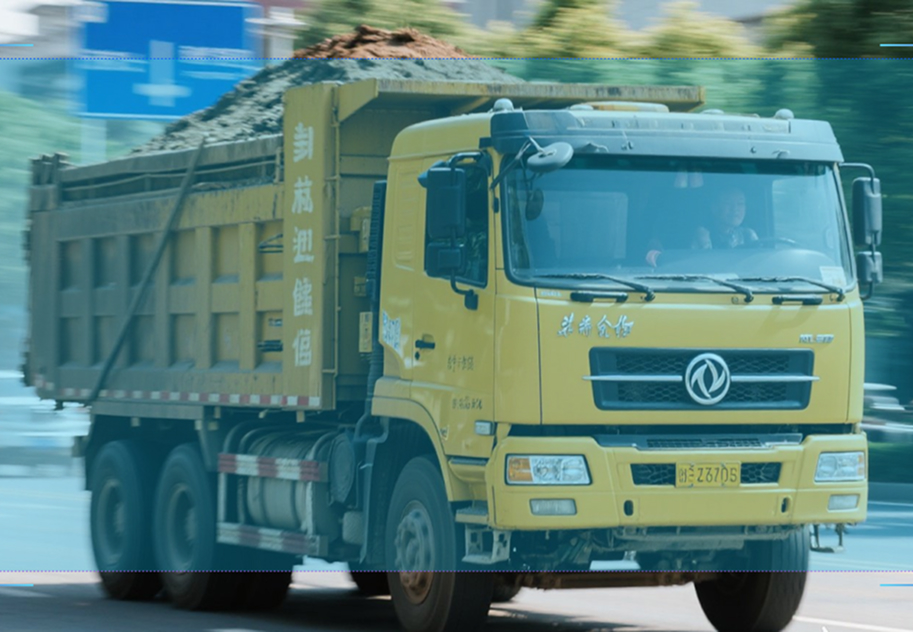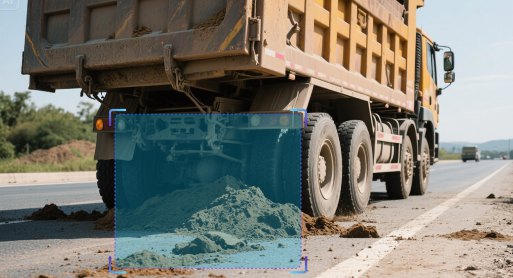
Dump Truck Uncovered Load Detection

Algorithm Introduction
Utilizing AI vision algorithms to detect uncovered cargo beds of construction waste trucks within designated monitoring areas, identifying both "uncovered + fully loaded" and "uncovered + empty load" violations, and outputting bounding boxes for both the vehicles and their uncovered cargo areas.
- ● Lighting conditions: Daytime and well-lit nighttime environments
- ● Image requirements: Optimal detection performance at 1920×1080 resolution
Application Value
-

Urban Roadways
The AI vision algorithm conducts real-time monitoring of key areas such as main roads, identifying uncovered dump trucks. This rapidly generates detection boxes for the entire vehicle and uncovered sections, effectively preventing issues like spillage, leakage, and dust pollution. -

Construction Sites
The system scans construction sites to accurately identify if dump truck compartments are sealed during entry and exit. It assists sites in dump truck management, reducing environmental pollution risks, and ensuring construction safety and the cleanliness of surrounding areas.
FAQ
-
Algorithm AccuracyAll algorithms published on the website claim accuracies above 90 %. However, real-world performance drops can occur for the following reasons:
(1) Poor imaging quality, such as
• Strong light, backlight, nighttime, rain, snow, or fog degrading image quality
• Low resolution, motion blur, lens contamination, compression artifacts, or sensor noise
• Targets being partially or fully occluded (common in object detection, tracking, and pose estimation)
(2) The website provides two broad classes of algorithms: general-purpose and long-tail (rare scenes, uncommon object categories, or insufficient training data). Long-tail algorithms typically exhibit weaker generalization.
(3) Accuracy is not guaranteed in boundary or extreme scenarios.
-
Deployment & InferenceWe offer multiple deployment formats—Models, Applets and SDKs.
Compatibility has been verified with more than ten domestic chip vendors, including Huawei Ascend, Iluvatar, and Denglin, ensuring full support for China-made CPUs, GPUs, and NPUs to meet high-grade IT innovation requirements.
For each hardware configuration, we select and deploy a high-accuracy model whose parameter count is optimally matched to the available compute power.
-
How to Customize an AlgorithmAll algorithms showcased on the website come with ready-to-use models and corresponding application examples. If you need further optimization or customization, choose one of the following paths:
(1) Standard Customization (highest accuracy, longer lead time)
Requirements discussion → collect valid data (≥1 000 images or ≥100 video clips from your scenario) → custom algorithm development & deployment → acceptance testing
(2) Rapid Implementation (Monolith:https://monolith.sensefoundry.cn/)
Monolith provides an intuitive, web-based interface that requires no deep AI expertise. In as little as 30 minutes you can upload data, leverage smart annotation, train, and deploy a high-performance vision model end-to-end—dramatically shortening the algorithm production cycle.






